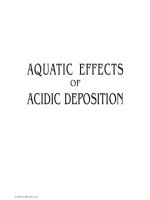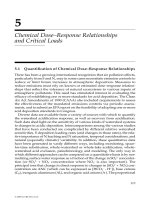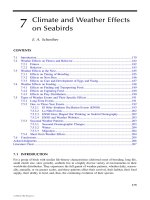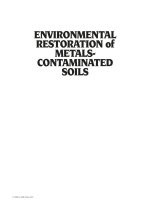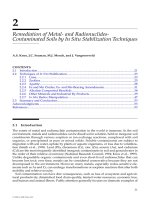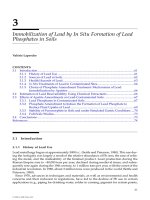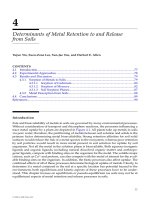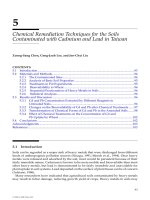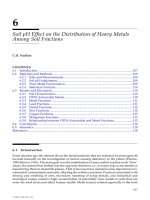ENVIRONMENTAL RESTORATION of METALSCONTAMINATED SOILS - CHAPTER 1 pdf
Bạn đang xem bản rút gọn của tài liệu. Xem và tải ngay bản đầy đủ của tài liệu tại đây (589.71 KB, 29 trang )
ENVIRONMENTAL
RESTORATION of
METALSCONTAMINATED
SOILS
© 2001 by CRC Press LLC
ENVIRONMENTAL
RESTORATION of
METALSCONTAMINATED
SOILS
Edited by
I.K. Iskandar
LEWIS PUBLISHERS
Boca Raton London New York Washington, D.C.
© 2001 by CRC Press LLC
4131/frame/fm Page 4 Friday, July 21, 2000 4:47 PM
Library of Congress Cataloging-in-Publication Data
Environmental restoration of metals-contaminated soils / edited by I.K. Iskandar.
p. cm.
Includes bibliographical references and index.
ISBN 1-56670-457-X (alk. paper)
1. Metals—Environmental aspects. 2. Soil remediation. I. Iskandar, I. K. (Iskandar
Karam), 1938–
TD879.M47 E58 2001
628.5′5—dc21
00-030172
CIP
This book contains information obtained from authentic and highly regarded sources. Reprinted
material is quoted with permission, and sources are indicated. A wide variety of references are listed.
Reasonable efforts have been made to publish reliable data and information, but the author and the
publisher cannot assume responsibility for the validity of all materials or for the consequences of
their use.
Neither this book nor any part may be reproduced or transmitted in any form or by any means,
electronic or mechanical, including photocopying, microfilming, and recording, or by any information
storage or retrieval system, without prior permission in writing from the publisher.
All rights reserved. Authorization to photocopy items for internal or personal use, or the personal or
internal use of specific clients, may be granted by CRC Press LLC, provided that $.50 per page photocopied is paid directly to Copyright Clearance Center, 222 Rosewood Drive, Danvers, MA 01923 USA.
The fee code for users of the Transactional Reporting Service is ISBN 0-56670-457-X/009/$0.00+$.50.
The fee is subject to change without notice. For organizations that have been granted a photocopy
license by the CCC, a separate system of payment has been arranged.
The consent of CRC Press LLC does not extend to copying for general distribution, for promotion,
for creating new works, or for resale. Specific permission must be obtained in writing from CRC
Press LLC for such copying.
Direct all inquiries to CRC Press LLC, 2000 N.W. Corporate Blvd., Boca Raton, Florida 33431.
Trademark Notice: Product or corporate names may be trademarks or registered trademarks, and
are used only for identification and explanation, without intent to infringe.
© 2001 by CRC Press LLC
Lewis Publishers is an imprint of CRC Press LLC
No claim to original U.S. Government works
International Standard Book Number 0-56670-457-X
Library of Congress Card Number 00-030172
Printed in the United States of America 1 2 3 4 5 6 7 8 9 0
Printed on acid-free paper
© 2001 by CRC Press LLC
4131/frame/fm Page 5 Friday, July 21, 2000 4:47 PM
Preface
During recent decades, phenomenal progress has been made in several areas of biology,
ecology, health, and environmental geochemistry of heavy metals in soils. Prior to the
1960s, research was focused on enhancing the plant uptake or availability of selected heavy
metals or minor elements (also referred to as micronutrients) from the soil. More recently,
concerns regarding heavy metals contamination in the environment affecting all ecosystem
components, including aquatic and terrestrial systems, have been identified with increasing efforts on limiting their bioavailability in the vadose zone.
Recently, many sites have been identified as hazardous waste sites because of the presence of elevated concentrations of heavy metals. In some cases, contamination of groundwater with metals that have potential health effects has also been discovered. The total
mass of metals in surface soils is an important factor influencing their migration in the soil
to the groundwater. However, soil environmental conditions and physical, chemical, and
biological processes are also important factors affecting the fate of metals in soils.
Unlike organic contaminants that can be destroyed (or mineralized) through treatment
technologies, such as bioremediation or incineration, metal contaminants cannot. Once a
metal has contaminated soil, it will remain a threat to the environment until it is removed
or immobilized. The cleanup techniques most used for the remediation of heavy metals
contamination are excavation and subsequent landfilling of the heavy metals-contaminated soil or waste (commonly referred to as “dig and haul”). Dig and haul does not
remove the contaminant from the waste but simply transfers the contamination from one
area to another. Usually, no effort is made to reduce the mobility of the heavy metals
beyond containment in a secured landfill.
Because of the concerns regarding the role of heavy metals in the environment, a series
of international conferences was held to explore the emerging issues of the biogeochemistry of trace elements in the environment. In June 1997, the Fourth International Conference
on the Biogeochemistry of Trace Elements was held in Berkeley, CA. The contributions in
this book were presented in part at this conference. This book, Environmental Restoration of
Metals-Contaminated Soils, follows earlier titles: Engineering Aspects of Metal-Waste Management, 1992, and Remediation of Soils Contaminated with Metals, 1997.
The contributors are a multidisciplinary group of scientists and engineers; the book
was written to update current information on environmentally accepted methods for site
restoration.
The book is organized in 14 chapters. The first eight chapters deal with the physical and
chemical methods and processes for soil remediation. The other six chapters focus on
selected biological methods and processes for remediation.
Chapters 1 and 2 describe physical-chemical processes for in situ remediation by adding
amendments for stabilization.
Chapter 3 considers the immobilization of lead. Chapter 4 describes the mechanics of
metal retention and release from soils. Chapter 5 describes a chemical remediation method
for soil contaminated with cadmium and lead.
Chapter 6 examines the effect of soil pH on the distribution of metals among soil fractions.
Chapters 7 and 8 describe physical and electrical separation methods for soil remediation.
The relationship between the phytoavailability and the extractability of heavy metals in
contaminated soils is discussed in Chapter 9, while Chapter 10 provides an overview on
© 2001 by CRC Press LLC
4131/frame/fm Page 6 Friday, July 21, 2000 4:47 PM
environmental restoration of selenium-contaminated soils. Chapter 11 discusses trace elements in soil-plant systems under tropical environment. The process of metal removal by
chelation using amino acids is presented in Chapter 12. Chapter 13 examines the effects of
natural zeolite and bentonite on the phytoavailability of heavy metals. Chapter 14 discusses
metal uptake by agricultural crops from sewage sludge-treated soils.
I thank the authors for their contributions. I am also grateful for their patience, valuable
time, and effort in preparing and critiquing the various chapters and in keeping the focus
on the main theme of soil remediation. I gratefully acknowledge the technical reviews provided by Dr. A.L. Page of the University of California, Riverside.
Without the support of the Center for Environmental Engineering, Science and Technology (CEEST) at the University of Massachusetts, Lowell, and the U.S. Army Cold Regions
Research and Engineering Laboratory (CRREL), this project could not have been achieved.
I thank Edmund A. Wright (since deceased) and Donna Harp of CRREL for their editing
and typing support. Finally, I thank my wife, Bonnie Iskandar, for her encouragement and
support and for allowing me to work at home many hours to complete this volume.
This volume is dedicated to the memory of the late Edmund A. Wright, who over the past
25 years provided me with technical editing.
Iskandar K. Iskandar
© 2001 by CRC Press LLC
4131/frame/fm Page 7 Friday, July 21, 2000 4:47 PM
Editor
Iskandar K. Iskandar earned his Ph.D. degree in soil science and water chemistry at the
University of Wisconsin–Madison, in 1972. He is a research physical scientist at the Cold
Regions Research and Engineering Laboratory (CRREL) and a Distinguished Research Professor at the University of Massachusetts, Lowell. He developed a major research program
on land treatment of municipal wastewater and coordinated a number of research areas
including transformation and transport of nitrogen, phosphorus, and heavy metals. He
also developed the Cold Regions Environmental Quality Program at CRREL which he
managed from 1985 to 1997. His recent research efforts have focused on the fate and transformation of toxic chemicals, development of non-destructive methods for site assessments, and evaluation of in situ and on-site remediation alternatives. Dr. Iskandar has
edited several books and published numerous technical papers. He organized several
national and international workshops, conferences, and symposia. He received a number
of awards including the Army Science Conference Award, CRREL Research and Development Award, and CRREL Technology Transfer Award. Dr. Iskandar is a fellow of both the
Soil Science Society of America and the American Society of Agronomy, and vice president
of the International Society of Trace Element Biogeochemistry.
© 2001 by CRC Press LLC
4131/frame/fm Page 9 Friday, July 21, 2000 4:47 PM
Contributors
Sultana Ahmed Bangladesh Institute of Nuclear Agriculture, Bangladesh
Akram N. Alshawabkeh Northeastern University, Department of Civil and Environmental
Engineering, Boston, Massachusetts 02115, U.S.A.
Herbert E. Allen Department of Civil and Environmental Engineering, University of
Delaware, Newark, Delaware 19716, U.S.A.
Alain Bermond Institut National Agronomique Laboratoire de Chimie Analytique, Paris,
France
R. Mark Bricka U.S. Army Corps of Engineers Engineering Research & Development
Center, Vicksburg, Mississippi 39180, U.S.A.
Lenom J. Cajuste Colegio de Postgraduados, Chapingo Montecillo, Mexico
Zueng-Sang Chen Graduate Institute of Agricultural Chemistry, National Taiwan University, Taipei, Taiwan
K.S. Dhillon Department of Soils, Punjab Agricultural University, Ludhiana, India
S.K. Dhillon Department of Soils, Punjab Agricultural University, Ludhiana, India
James A. Holcombe Department of Chemistry and Biochemistry, University of Texas,
Austin, Texas 78712, U.S.A.
Maury Howard Department of Chemistry and Biochemistry, University of Texas, Austin,
Texas 78712, U.S.A.
Achim Kayser Swiss Federal Institute of Technology, Institute of Terrestrial Ecology, Soil
Protection Group, Zürich, Switzerland
Armin Keller Swiss Federal Institute of Technology, Institute of Terrestrial Ecology, Soil
Protection Group, Zürich, Switzerland
Catherine Keller Swiss Federal Institute of Technology, Institute of Terrestrial Ecology,
Soil Protection Group, Zürich, Switzerland
A.S. Knox (formerly A. Chlopecka) Savannah River Ecology Laboratory, University of
Georgia, Aiken, South Carolina 29802, U.S.A.
Reggie J. Laird Colegio de Postgraduados, Chapingo Montecillo, Mexico
© 2001 by CRC Press LLC
4131/frame/fm Page 10 Friday, July 21, 2000 4:47 PM
Valérie Laperche
France
Centre National de Recherche sur les Sites et Sols Pollués, Douai,
Geng-Jauh Lee Graduate Institute of Agricultural Chemistry, National Taiwan University,
Taipei, Taiwan
Suen-Zone Lee Department of Environmental Engineering and Health, Chia Nan College
of Pharmacy and Science, Tainan, Taiwan
Jen-Chyi Liu Department of Agricultural Chemistry, Taiwan Agricultural Research Institute,
Council of Agriculture, Taichung, Taiwan
M.J. Mench
France
Centre Bordeaux-Aquitaine, INRA Agronomy Unit, Villenave d’Ornon,
S.M. Rahman Bangladesh Institute of Nuclear Agriculture, Mymensingh, Bangladesh
Rainer Schulin Swiss Federal Institute of Technology, Institute of Terrestrial Ecology, Soil
Protection Group, Zürich, Switzerland
J.C. Seaman Savannah River Ecology Laboratory Advanced Analytical Center for Environmental Science, University of Georgia, Aiken, South Carolina 29802, U.S.A.
László Simon College of Agriculture, Gödöllõ University of Agricultural Sciences,
Nyiregyhaza, Hungary
C.D. Tsadilas Institute of Soil Classification and Mapping, National Agricultural Research
Foundation, Larissa, Greece
J. Vangronsveld Limburgs Universitair Centrum, Environmental Biology Universitaire
Campus, Diepenbeek, Belgium
Clint W. Williford, Jr.
Oxford, Mississippi
Department of Chemical Engineering, University of Mississippi,
Yujun Yin Department of Civil and Environmental Engineering, University of Delaware,
Newark, Delaware 19716, U.S.A.
Sun-Jae You Department of Marine Environmental Engineering, Kunsan National University, Republic of Korea
Isabelle Yousfi (deceased) IPSN\DPRE\SERGD\Laboratoire d’Étude des Stockages de
Surface, Fontenay-aux-Roses, France
© 2001 by CRC Press LLC
4131/frame/fm Page 11 Friday, July 21, 2000 4:47 PM
Contents
Section I
Physical and Chemical Methods and Processes
1. Physical-chemical approach to assess the effectiveness of
several amendments used for in situ remediation of
trace metals-contaminated soils by adding solid phases ....................................3
Isabelle Yousfi and Alain Bermond
2. Remediation of metal- and radionuclides-contaminated soils by in situ
stabilization techniques .......................................................................................21
A.S. Knox*, J.C. Seaman, M.J. Mench, and J. Vangronsveld
3. Immobilization of lead by in situ formation of lead phosphates in soil ...........61
Valérie Laperche
4. Determinants of metal retention to and release from soils ...............................77
Yujun Yin, Suen-Zone Lee, Sun-Jae You, and Herbert E. Allen
5. Chemical remediation techniques for the soils contaminated with
cadmium and lead in Taiwan .................................................................................93
Zuen-Sang Chen, Geng-Jauh Lee, and Jen-Chyi Liu
6. Soil pH effect on the distribution of heavy metals among soil fractions ....... 107
C.D. Tsadilas
7. Physical separation of metal-contaminated soils ............................................. 121
Clint W. Williford, Jr. and R. Mark Bricka
8. Heavy metals extraction by electric fields ........................................................ 167
Akram N. Alshawabkeh and R. Mark Bricka
Section II
Biological Methods and Processes
9. The relationships between the phytoavailability and the extractability of
heavy metals in contaminated soils .................................................................. 189
Lenom J. Cajuste and Reggie J. Laird
10. Restoration of selenium-contaminated soils .................................................... 199
K.S. Dhillon and S.K. Dhillon
11.
Trace metals in soil-plant systems under tropical environment ..................... 229
Sultana Ahmed and S.M. Rahman
* Formerly A. Chlopecka
© 2001 by CRC Press LLC
4131/frame/fm Page 12 Friday, July 21, 2000 4:47 PM
12. Polyamino acid chelation for metal remediation ............................................. 243
Maury Howard and James A. Holcombe
13. Effects of natural zeolite and bentonite on the phytoavailability of
heavy metals in chicory ..................................................................................... 261
László Simon
14. Heavy-metal uptake by agricultural crops from sewage-sludge
treated soils of the Upper Swiss Rhine Valley and the effect of time ............. 273
Catherine Keller, Achim Kayser, Armin Keller, and Rainer Schulin
© 2001 by CRC Press LLC
4131/frame/C01 Page 1 Friday, July 21, 2000 5:00 PM
Section I
Physical and Chemical Methods
and Processes
© 2001 by CRC Press LLC
4131/frame/C01 Page 3 Friday, July 21, 2000 5:00 PM
1
Physical-Chemical Approach to Assess the
Effectiveness of Several Amendments Used for In Situ
Remediation of Trace Metals-Contaminated Soils by
Adding Solid Phases
Isabelle Yousfi (deceased) and Alain Bermond (corresponding author)
CONTENTS
1.1 Introduction............................................................................................................................ 3
1.1.1 Remediation Techniques ...........................................................................................4
1.1.2 In Situ Remediation by Adding Solid Phase ..........................................................4
1.2 Example of Study to Assess the Effectiveness of Several Amendments ........................7
1.2.1 Methods .......................................................................................................................7
1.2.1.1 Soil Characteristics ......................................................................................7
1.2.1.2 Rapid Characterization of the Solid Phases Used as Amendments.....8
1.2.1.3 Calculation of the Amendment Effect ....................................................10
1.2.1.4 Analytical Methods ...................................................................................13
1.3 Results and Discussion ........................................................................................................14
1.4 Conclusion.............................................................................................................................17
References .......................................................................................................................................20
1.1
Introduction
The increasing use of trace metal-contaminated sewage sludge as agricultural fertilizer or
the storage of polluted wastes can cause toxic elements to accumulate in soils. After complex processes, these elements may pass into the soil solution where plant uptake or leaching to groundwater can contaminate the food chain.
Thus, increasing contamination of agricultural soil by toxic compounds such as heavy
metals, metalloids, or organic pollutants has important health and economic implications.
With this in mind, several cleanup methods have been investigated, which can be divided
into two groups: those that remove contaminants, and those that transform pollutants into
harmless forms (immobilization) by fixation, oxidation, etc. These cleanup technologies
can be applied on- or off-site, utilizing three kinds of remediation treatments: biological,
physical, and chemical techniques.
3
© 2001 by CRC Press LLC
4131/frame/C01 Page 4 Friday, July 21, 2000 5:00 PM
4
1.1.1
Environmental Restoration of Metals–Contaminated Soils
Remediation Techniques
Biological treatments generally consist of in situ remediation and biodegradation, relying
on microbiological activities to remove contaminants, which in most cases are organic pollutants. This technique is being used to remove HAPs or PBCs (Hamby, 1996) or to transform pollutants to harmless forms. It is an immobilization technique involving, for
example, photolysis of organic compounds. Another biological cleanup approach is the
cultivation of plants, called hyperaccumulators, that are able to accumulate one or several
toxic elements. This method has been successfully used for different toxic trace elements,
for instance Cd and Zn (Keller et al., 1997) or nickel (Homer et al., 1991).
Physical treatments remove contaminants through physical means. Among these
approaches are thermal desorption or vapor stripping of semi-volatile or volatile compounds. Electrokinetic migration, useful for anionic and cationic compound extraction, can
also be mentioned (Chapter 8).
Chemical treatments include all techniques involving reagents or external compounds.
Soil washing is one. In this technique different reagents able to solubilize toxic elements are
coupled with the removal of leaching solutions and added chelators that make cations less
labile, thus allowing them to immobilize toxic elements in a less bioavailable form. For
instance, EDTA is one of the proposed complexing reagents (Li and Shuman, 1996). In addition, adding solid phases should also be mentioned. Solid phases can fix (irreversibly) toxic
elements, and they can sometimes be used to reduce remediation costs.
Among these different remediation techniques, this chapter focuses on this last method.
Adding solid phases is an interesting and low-cost technique.
1.1.2
In Situ Remediation by Adding Solid Phase
The question here is what will the effect be of adding the following different kinds of amendments to contaminated soils: clay minerals, hydrous iron oxides (HFO), hydrous manganese
oxides (HMO), fly ashes, etc. Two kinds of studies have been carried out. The first type consists of plant studies, in which some authors conducted experiments on the effect of amendments on the uptake of trace elements by plants. They did this by comparing the amounts
of cadmium, lead, copper, or zinc in plants grown on contaminated soils with or without
amendments (Gworek, 1992a, 1992b; Wong and Wong, 1990; Petruzzelli et al., 1987; Chlopecka and Adriano, 1997). For instance, Gworek (1992a) studied the effect of adding synthetic zeolites on the amount of Cd in lettuce, oats, and ryegrass. She noted a significant
decrease in Cd in plant tissue in 85% of lettuce leaves and about 45% of lettuce roots.
Chlopecka and Adriano (1997) worked with four different soils and studied the effect of
two kinds of zeolite and apatite on the amount of Cd, Zn, and Pb in maize tissue. Among the
results shown, they found a decrease of about 50% of Pb in maize leaves grown on a zeoliteamended soil, and a 20% reduction in Cd content in maize grown on apatite-amended soil.
Fly ashes are used as agricultural amendments, too, particularly because they are lowcost wastes. Petruzzelli et al. (1987) have added from 0 to 5% (w/w) fly ash to soils and
studied the amount of Cu, Ni, Cr, and Zn in wheat seedlings. Amendments seem to have a
useful effect and result, for instance, in a decrease of about 65% of Zn in roots when 5% fly
ash is added. Wong and Wong (1990) have also studied fly ashes and mixed coal fly ashes
at rates of 0, 3, 6, and 12% in two soils. If they divided the amount of Zn in vegetables
(cabbages) by a factor of two, the authors then noticed an increase of soil pH and a decrease
in several cases of the vegetal yield. They concluded that there was a possible phytotoxic
effect of fly ashes. However, the liming effect involved adding fly ashes, implying that the
lowered bioavailability of oligo-elements can be another assumption, as Waren et al. (1993)
and Davies et al. (1993) have assumed.
© 2001 by CRC Press LLC
4131/frame/C01 Page 5 Friday, July 21, 2000 5:00 PM
Physical-Chemical Approach to Assess the Effectiveness of Several Amendments
5
Although the range of effects varied with the plants studied, in most cases the amendments brought about a reduction of trace metal concentrations in plant tissues. However,
in the case of fly ashes, an important variation of soil pH after application was noticed, and
a correlation between trace element concentrations in the plant and the pH of the amended
soil was found (Wong and Wong, 1990).
In another approach to remediation, some authors studied the correlation between trace
elements in plants and soils. In this case, the quantities of trace metals in soils were determined using chemical fractionation procedures, before and after the amendments. A few
examples can be given. Pierynski and Schwab (1993) have studied the effect of limestone,
N Viro Soil, or phosphates on the content of Zn, Cd, and Pb in soybean tissues. In other
tests, chemical extraction procedures have been carried out on soils amended or not. By
means of these protocols, they observed a redistribution of trace elements between soil fractions; in addition, several phases seem to improve plant quality. Thus, they noted that limestone can decrease about 65% of Zn and 33% of Cd in plant tissue. Adding N Viro Soil
resulted in a decrease of 33% of Pb in leaves.
Sappin-Didier et al. (1994), after adding 1% (w/w) of steel shot to two different soil samples, have studied the amount of Ni, Cr, and Pb in ryegrass and tobacco. Among their
results, they showed that Cd can be decreased by 40% in tobacco. Simultaneously, the fractions of extractable Cd H2O and Ca(NO3)2 decrease about 75 and 85%, respectively. With
the same plants, Mench et al. (1994) have studied the effect of lime, HFO, HMO, and
zeolites on different types of soils. Among their results, they found that the amount of Cd
decreases by 75% in ryegrass roots grown on HMO-amended soils and by 50% in tobacco
grown under the same conditions. In addition, lead content in plant tissue significantly
decreases with HMO (–75%) or lime (–65%).
Davies et al. (1993) studied the effect of adding agricultural limestone to soils contaminated with different ranges of trace metals. The EDTA extractable fractions of Cd, Pb, and
Zn were studied before and after amendment; in addition, the total content of trace elements in radishes was investigated. For single application, Davies et al. (1993) noticed,
under the best conditions, a decrease of Zn and Pb in vegetative tissue of about 20%, while
the EDTA-extractable fraction of zinc and lead in soil also decreased.
From a general point of view, chemical extractions showed that the amendments resulted
in changes in the fractionation of trace elements available to crops.
Amendments with solid phases such as fly ashes (Wong and Wong, 1990; Petruzzelli et al.,
1987; Pierzynski and Schwab, 1993), limestone, K2PO4, or hydrous manganese oxides and
hydrous iron oxides (Wong and Wong, 1990; Petruzzelli et al., 1987; Pierzynski and Schwab,
1993; Sims and Kline, 1991; Mench et al., 1994) and zeolites (Gworek, 1992a, 1992b; Chlopecka and Adriano, 1997) can influence plant uptake, but unfortunately, these amendments
can also influence the physicochemical parameters of the soil, particularly its pH. These
changes influence the effectiveness of amendments, but they are rarely taken into account.
Several studies mention the effect on pH value of adding solid phases. For instance,
Wong and Wong (1990) show that the pH value can increase from 1.5 to 2 units by adding
alkaline fly ashes. With fly ashes, too, Petruzzelli et al. (1987) observed a decrease by a third
of Ni in roots, and they also observed simultaneous pH increases from 6.1 to 8.5. Davies et
al. (1993) underline the accepted liming effect of agricultural limestone and note an increase
of pH from 5.9 before amendment to 7.5 after adding limestone. Waren et al. (1993), studying the bioavailability of B, Ca, Cr, Zn, Cu, and Ni for wheat seedlings grown on fly ashamended soils, have seen an increase in pH, accompanied by a decrease in crop yield. They
explain their results by a decreased availability of plant essential elements.
Although solid phases in most cases change pH value, the liming effect is not general. For
instance, Juste and Soldâ (1988) have studied the effect of ammonium sulphate, calcium
carbonate, acid peat, HFO, and steel shot on the total content of Cd, Ni, Zn, and Mn in
© 2001 by CRC Press LLC
4131/frame/C01 Page 6 Friday, July 21, 2000 5:00 PM
6
Environmental Restoration of Metals–Contaminated Soils
TABLE 1.1
Effect of Different Amendments on Soil pH Value and Amount of Zn, Cd, and Ni in Ryegrass
(First cut in µg·kg–1; the effect is calculated as (soil – soil + amendment)/soil)
pH
[Cd] (effect)
5.5
4.9
7.4
5.4
5.2
6.4
Soil
+ Ammonium sulfate
+ CaCO3
+ Acid peat
+ HFO
+ Steel shot
[Zn] (effect)
130
204 (+57%)
97 (–25%)
137 (+3%)
117 (–17%)
65 (–50%)
18
27 (+50%)
12 (–33%)
19 (+5%)
16 (–18%)
6 (–66%)
[Ni] (effect)
61
99
39
65
55
26
(+62%)
(–36%)
(+6%)
(–10%)
(–57%)
Source: Juste, C. and P. Soldâ. Influence de l’addition de différentes matières fertilisantes sur la biodisponibilité
du cadmium, du manganèse, du nickel et du zinc contenus dans un sol sableux amendé par des boues de station
d’épuration. Agronomie, 8(10) 897–904, 1988. With permission.
ryegrass. They observed, for example, Zn in the first cut of ryegrass was increased by a factor of 1.6 by adding ammonium sulfate while the pH value decreased from 5.5 to 4.9, but
Zn decreased about 25% by adding lime up to pH 7.4. Similar results were obtained for Cd
and Ni. These results are summarized in Table 1.1.
These possible changes of the physicochemical parameters make it difficult to interpret
the influence of amendment action on the immobilization of trace metals. It is not easy, for
instance, to distinguish the true fixation of trace elements onto the added solid phase from
a lower availability of the element due to the effect of an increasing pH that enhances the
fixation of trace metals onto the soil voids. Actually, the role of soil pH on the solubility of
trace metals such as lead or cadmium is well known: the trace metals released in solution
increase when the pH decreases (Sims, 1986). Moreover, comparisons of the effects of different amendments are quite difficult, if made simultaneously, for the same sample, pH,
and added phase. Finally, it can be assumed that the plant studies do not give any informaconcentration of
trace elements in
the soil solution
soil
amended soil
effect of
added phase
pH e
pH of soil solution
FIGURE 1.1
Schematic representation of the determination of the amendment effect at a given pH (pHe). Curves correspond
to the possible relative position of the extracted trace metal amounts vs. pH without and with amendments,
respectively. Solid line represents extracted trace metal amounts from soil without amendment vs. pH; it is a
“reference curve” to assess amendment effect. Dotted lines represent extracted trace metal amounts vs. pH from
soil mixed with amendment whose fixation effect involves a decrease of total extracted amount (at a given pH).
© 2001 by CRC Press LLC
4131/frame/C01 Page 7 Friday, July 21, 2000 5:00 PM
Physical-Chemical Approach to Assess the Effectiveness of Several Amendments
7
tion about how effective immobilization will be to prevent migration toward waters
(groundwaters, but also surface waters).
The aim of the present study was to estimate the trace metal immobilization potential of
different amendments, that is to say, the removal of trace metals from the soil solution using
a physicochemical approach. Therefore, because soil parameters such as pH are important,
we tried to quantitatively determine the effect of several amendments under different
physicochemical conditions (i.e., different chemical reagents). Then we compared the
amount of trace metals extracted with a given chemical reagent from soils with or without
amendment, at the same pH, as is shown on Figure 1.1.
This approach allows us to estimate the true potential of a given amendment and the
effect of pH on it to remove trace metals from the solution; it also allows us to compare,
from this point of view, different amendments and, thus, gives a fast and reliable way to
choose the more appropriate amendment for a given soil.
1.2
Example of Study to Assess the Effectiveness of Several Amendments
In this study, we have investigated the effect of several amendments on two contaminated
soils when the samples were subjected to a chemical reagent simulating conditions enhancing exchange phenomena or reducing conditions:
• A solution of Ba(ClO4)2 (0.5 mol·L–1) was used to assess the reactivity of trace
elements when the soil samples were subjected to an exchanger medium simulating natural physicochemical conditions that may occur when a soil receives
industrial effluents, fertilizers, or deicing salts from nearby roadways.
• NH2OH·HCl (0.1 mol·L–1) was used to estimate trace metal behavior when the
sample was subjected to reducing conditions that are, for instance, able to occur
during flooding.
1.2.1
Methods
1.2.1.1 Soils Characteristics
Two soil samples contaminated by trace metals were used in this study. The first one, named
Couhins, is a sewage sludge treated soil; the other, named Evin, is contaminated by industrial atmospheric depositions. Table 1.2 gives their main physicochemical characteristics.
As discussed earlier (see Figure 1.1), several experiments were carried out to plot the
amounts of trace elements released as a function of pH at equilibration time. The resulting
graphs will be our references to estimate, at a given pH, the effect of the added phase. In a
first set of experiments, the soil sample (1 g) and the reagent, Ba(ClO4)2 or NH2OH·HCl
(50 mL), were shaken with a mechanical stirrer, for different equilibration times determined by kinetic study, i.e., 140 min in barium perchlorate solution or 24 h in reducing solution. After mixing, the pH of the solution, pHe, was measured; the amounts of extracted
trace elements (Zn, Cd, Cu, Pb) or major elements (Ca, Mg, Fe, Mn) were determined to
establish “reference curves.”
Figure 1.2 shows the amount of Zn and Cd extracted using barium perchlorate solution.
In the same way, Figure 1.3 represents the amount of Zn and Cd extracted in reducing conditions, obtained when using hydroxylamine solution.
© 2001 by CRC Press LLC
4131/frame/C01 Page 8 Friday, July 21, 2000 5:00 PM
8
Environmental Restoration of Metals–Contaminated Soils
TABLE 1.2
Physical-Chemical Characteristics of the Studied Soil Samples
Evin
8.56
1.8
16.5
1,415
23
1,120
43.5
20,900
411
7,600
33,000
pH
Organic matter
Clay (%)
Zinc (µg·g–1)
Cadmium (µg·g–1)
Lead (µg·g–1)
Copper (µg·g–1)
Iron (µg·g–1)
Manganese (µg·g–1)
Calcium (µg·g–1)
Magnesium (µg·g–1)
Couhins
7.64
2.2
2.9
151
94.9
44.8
45.3
3,526
40.4
1,486
212
TABLE 1.3
Total Trace Element Contents of the Studied Amendments (µg·g–1)
Element
Zinc
Cadmium
Lead
Copper
Iron
Manganese
Calcium
Magnesium
HMO
HFO
Clay
O.M.
EDF
Valenton
10.7
9
0
0
55.7
622,200
77
6.2
0
0
0
4.8
28,120
39.2
0
0
57.5
4.7
0
10
710
358
6,150
6,500
49.1
0
0
0
10,400
44.4
10,106
1,097
849
0.71
323
233
60,150
291
5,233
5,175
2,912
15.4
1,270
1,900
20,670
13,441
77,300
4,334
Whatever the trace element is, the importance of solution pH on the quantity of toxic elements in soil solution can be seen: the extracted amount increases as pH decreases. This a
well-known effect (Sims, 1986), demonstrating the extracting effect of protons.
1.2.1.2 Rapid Characterization of the Solid Phases Used as Amendments
Six solid phases were used:
• Synthetic compounds: hydrous manganese oxide (HMO), a goethite (HFO), a
clay (a montmorillonite), and fulvic acids (O.M. [organic matter])
• Wastes: two kinds of fly ashes, one being a coal fly ash (EDF), the other a product
of sewage sludge combustion from the Valenton Wastewater Plant, called in this
study “Valenton”
The trace metal composition (total concentration) of these phases is given in Table 1.3.
Synthetic phases, such as HMO, HFO, clay, or O.M., are weakly polluted by trace metals,
as opposed to fly ashes that are strongly contaminated. Nevertheless, these compounds
could have a good remediation capacity if trace elements are strongly bound and not easily
released under the studied physical chemical conditions.
To assess the ability of these phases to remediate polluted soils and to fix trace elements, a
rapid study of their capacity to fix several trace elements was performed. Figures 1.4 and 1.5
and Tables 1.4 and 1.5 give the percentage of cations adsorbed by each phase in each
medium [Ba(ClO4)2 or NH2OH·HCl] at different pHs: only the results for trace elements
leached from soil samples in different media have been shown here [Cd and Zn in
© 2001 by CRC Press LLC
4131/frame/C01 Page 9 Friday, July 21, 2000 5:00 PM
Physical-Chemical Approach to Assess the Effectiveness of Several Amendments
9
Evin sample
20
600
18
500
16
400
12
10
300
8
6
[Zn](µg.g-1)
[Cd](µg.g-1)
14
Zn
Cd
200
4
100
2
0
0
2
4
6
8
pHe
Couhins sample
100
70
90
60
80
60
40
50
30
40
30
[Zn](µg.g-1)
50
70
[Cd](µg.g-1)
Zn
Cd
20
20
10
10
0
0
2
3
4
5
6
pHe
FIGURE 1.2
“Reference curve” in exchanger medium (0.5 M) Ba(ClO4)2. Amount of cations extracted from soil — without
amendment — as function of pH at equilibration time (pHe).
Ba(ClO4)2 medium and Cd, Zn, Pb for NH2OH·HCl solution]. The ratio of solid to solution
(1 to 2% w/w) and the equilibration times used were equal to those used for experiments
carried out with soil samples. The initial concentrations were 0.4 mg·L–1 for zinc, 0.2 mg·L–1
for cadmium, and 5 mg L–1 for lead. In the reducing medium, the number of usable phases
was limited as we had to eliminate HMO and HFO because they are easily destroyed by
such a reducing agent.
In most cases, the fixation of trace metals increases when pH is increased. Moreover,
some results do not show the fixation effect of the phase. For instance, clay minerals do not
© 2001 by CRC Press LLC
4131/frame/C01 Page 10 Friday, July 21, 2000 5:00 PM
10
Environmental Restoration of Metals–Contaminated Soils
Couhins sample
100
90
Zn
Cd
80
70
[C](µg.g-1)
60
50
40
30
20
10
0
2
3
4
5
6
pHe
Couhins sample
900
16
800
14
700
12
600
10
500
8
400
6
300
4
200
2
100
0
[Zn] and [Pb] (µg.g-1)
1000
18
[Cd](µg.g-1)
20
Zn
Pb
Cd
0
0
2
4
6
8
pHe
FIGURE 1.3
“Reference curve” for reducing medium (0.1 M) NH2OH·HCl. Amount of cations extracted from soil — without
amendments — as function of pH at equilibration time (pHe).
fix Zn or Cd in the exchanger medium. A competition of these trace elements with Ba2+ ions
may be involved, which could explain these results.
Zn and Cd exhibit a similar behavior, while more Pb seems to be fixed. Finally, from a
general point of view, it could be noticed that even polluted phases are able to diminish
total content of trace metals in solution.
1.2.1.3 Calculation of the Amendment Effect
To assess the amendment effect, a second set of experiments was undertaken in each
medium for a mixture of soil sample (1 g) plus solid phase in 50 mL of solution. In this case,
the amount of solid phase added is 10 mg for EDF, Valenton, O.M., and HMO, 12.5 mg for
© 2001 by CRC Press LLC
4131/frame/C01 Page 11 Friday, July 21, 2000 5:00 PM
Physical-Chemical Approach to Assess the Effectiveness of Several Amendments
(a)
100
% adsorbed
80
Zn
Cd
60
40
20
0
5
10
15
pH
(b)
90
80
% adsorbed
70
60
Zn
Cd
50
40
30
20
10
0
5
10
15
pH
(c)
40
% adsorbed
35
30
25
Zn
Cd
20
15
10
5
0
2
4
6
8
pH
FIGURE 1.4
Amount of cations adsorbed (%) in Ba(ClO4)2 medium for (a) organic matter, (b) HFO, and (c) Valenton.
© 2001 by CRC Press LLC
11
4131/frame/C01 Page 12 Friday, July 21, 2000 5:00 PM
12
Environmental Restoration of Metals–Contaminated Soils
(a)
100
90
80
70
60
Zn
Cd
Pb
50
40
30
20
10
0
2
4
6
8
pH
35
(b)
30
25
20
Zn
Cd
Pb
15
10
5
0
2
4
6
8
pH
FIGURE 1.5
Amount of cations adsorbed (%) in NH2OH·HCl medium, for organic matter (a) and clay (b).
HFO, and 20 mg for clay. After equilibration time (i.e., 1440 min or 24 h), the pHe was
recorded and trace element concentrations in solution were determined.
The effect E produced by the added solid phase was then calculated as follows:
E (%) = 100 × [(R – A) / R]
(1)
where A is the amount of trace metals released from mixing the soil sample and amendment at a given pHe, and R is the amount of trace metals released from the soil sample without amendment, presented on the reference curves at the same pH. The input of trace
elements was adjusted by the phase, but in fact this correction was not necessary because
the amounts of trace elements brought by the phase were always (much) smaller than the
amount released by soil.
© 2001 by CRC Press LLC
4131/frame/C01 Page 13 Friday, July 21, 2000 5:00 PM
Physical-Chemical Approach to Assess the Effectiveness of Several Amendments
13
TABLE 1.4
Percentage of Cations Adsorbed by Amendments in Ba(CI)4)2 Medium
pH
Zn
Cd
a
b
HMOa
Clayb
EDFa
4
6
7
4
6
7
9
66
98
38
66
73
0
0
0
0
0
0
0
5
21
0
0
0
10 mg has been mixed to 50 mL of solution.
20 mg has been mixed to 50 mL of solution.
TABLE 1.5
Percentage of Adsorbed Cations by Amendments in NH2OH·HCl Medium
pH
Zn
Cd
Pb
a
EDFa
Valentona
4
6
4
6
4
6
0
0
0
0
3
8
8
22
0
6
32
96
10 mg has been mixed to 50 mL of solution.
TABLE 1.6
Comparison of E Values in Both Media at pHe about 6 — Evin Sample
Zinc
BA(CIO4)2
Valenton
EDF
Clay
HMO
HFO
a
NH2OH
42
28
28
90
42
20
16
23
a
a
Cadmium
Ba(CIO4)2
NH2OH
29
32
28
56
30
7
5
4
a
a
These phases are destroyed in reducing medium.
+
Assuming an error on the amount experimentally determined equal to − 10%, we have
therefore considered that the influence of amendment was significant when the value of E
was higher than 20 (Table 1.6).
1.2.1.4 Analytical Methods
Solutions were analyzed with a flame atomic absorption spectrophotometer equipped with
an air-acetylene flame. The following wavelengths were used: 213.9 nm for Zn, 228.8 nm
for Cd, 324.8 nm for Cu, and 283.3 nm for Pb. The external standards method was chosen,
and standards were made with NH2OH·HCl (0.1 mol·L–1) or Ba(ClO4)2 (0.5 mol·L–1) solutions obtained from analytical grade salts, titrisol solutions, and pure MilliQ water.
© 2001 by CRC Press LLC
4131/frame/C01 Page 14 Friday, July 21, 2000 5:00 PM
14
1.3
Environmental Restoration of Metals–Contaminated Soils
Results and Discussion
Figure 1.6 shows the values of E and pHe obtained when the samples are leached with barium perchlorate solution. As Ba(ClO4)2 is a weak reagent, only Zn and Cd were extracted
from our samples and measured.
Whatever the compound added to the Evin sample, the effect of E involved was obvious
and higher than 20. In the case of the Couhins sample, the range of pHe was lower and the
influence of solid phase addition was slightly more complicated. It can be said from a general point of view that the effect E depends on the final pH, the amendment, the soil sample,
and the studied cation:
• The E value is generally higher for Zn than Cd; for example, the amount of Zn
in the soil solution for Evin sample diminishes about 90% by HMO addition,
while the amount of Cd in soil solution is simultaneously reduced to 60%.
• The value of E also depends on pHe and, moreover, its evolution with pH is
not necessarily the same as the variation of the percentage of fixed cations by
the amendment with pH, as is expected. For instance, the E value increases for
Valenton amended soil (Evin) when pH decreases, while the quick phase characterization shows the percentage of adsorbed Zn decreases as pH decreases
(see Table 1.4 and Figure 1.4).
• The E value for the same pHe is also a function of the studied soil sample. The
studied amendments seem to give a more effective remediation for the Evin
sample. Several explanations could be proposed. The presence of competitive
cations in solution or different chemical form of cations (Cd2+, CdOH+, CdCl+…)
can affect the potential of trace metal fixation by amendment (Bar-Tal et al., 1988;
Fu et al., 1991; Garcia-Miragaya and Page, 1977). In other respects, the nonlinear
adsorption isotherm can be mentioned. For the same phase, the amounts released
in solution from the Evin and Couhins samples are different (see reference curve,
for a given pHe); the amount of trace metals to be fixed by a phase thus differs.
According to these results, to remediate soils submitted to media enhancing exchange phenomena, HMO seems to be the best amendment. It is able to significantly reduce Zn as well
as Cd concentrations in soil solutions.
Figure 1.7 shows the results obtained in the NH2OH-HCl medium. As previously mentioned for the barium perchlorate medium, the calculated effect of E under reducing conditions depends on the amendment, the soil sample, and the studied cation. O.M. seems to
be the best amendment to reduce the concentration of trace metals in the solution. On the
other hand, other compounds, as fly ashes, seem ineffective in this condition to significantly influence the amounts of toxic trace elements in solution.
The comparison of results obtained for the same sample in both media (Figures 1.6 and 1.7)
points out that the effectiveness of a given phase depends also on the studied medium.
Thus, for pHe about 6, the E values obtained in barium perchlorate medium are different
from those obtained under reducing conditions (see Table 1.6). For instance, fly ashes
(Valenton and EDF) are able to limit the Cd content in Evin soil solution in the barium perchlorate medium — E values are equal to 29 and 32% — but seem to be largely unable to
limit Cd concentration released in the NH2OH·HCl medium. (E values were equal to 7 and
5%, respectively, and considered non-significant.) Several explanations could be proposed
© 2001 by CRC Press LLC
4131/frame/C01 Page 15 Friday, July 21, 2000 5:00 PM
Physical-Chemical Approach to Assess the Effectiveness of Several Amendments
15
EVIN sample
E
100
90
80
70
60
(%) 50
40
30
20
10
0
pHe
(a)
6.03 3.8
5.43 4.34
Valenton
4.85
EDF
HMO
5.94
HFO
3.58
zinc
cadmium
4
5.25
Clay
O.M
COUHINS sample
E
100
90
80
70
60
(%) 50
40
30
20
10
0
pHe
(b)
6.5
6.02
6.78
Valenton
EDF
5.9
6.01
HMO
6.65
HFO
5.95
zinc
cadmium
6
Clay
6.44
O.M
FIGURE 1.6
E values calculated for both (a) Evin and (b) Couhins soil samples in perchlorate barium solution (E calculated
from Equation 1).
— competition, nonlinear isotherms, etc. However, according to these results, a tracemetal-polluted soil subjected to reducing conditions seems to be more difficult to remediate
by immobilization techniques; the amendments seem to involve a lower reduction of the
toxic trace element concentration in solution, and the number of phases able to be used in
this medium is limited.
© 2001 by CRC Press LLC
4131/frame/C01 Page 16 Friday, July 21, 2000 5:00 PM
16
Environmental Restoration of Metals–Contaminated Soils
EVIN sample
40
(a)
20
E (%)
0
pHe
zinc
cadmium
lead
-20
5.9
4.89
Valenton
5.82
EDF
5.73
Clay
5.87
4.21
O.M
COUHINS sample
40
(b)
20
E (%)
0
zinc
cadmium
-20
pHe
5.76
Valenton
5.8
EDF
5.8
Clay
5.71
O.M
FIGURE 1.7
E values calculated for both (a) Evin and (b) Couhins soil samples under reducing conditions (E calculated from
Equation 1).
© 2001 by CRC Press LLC
